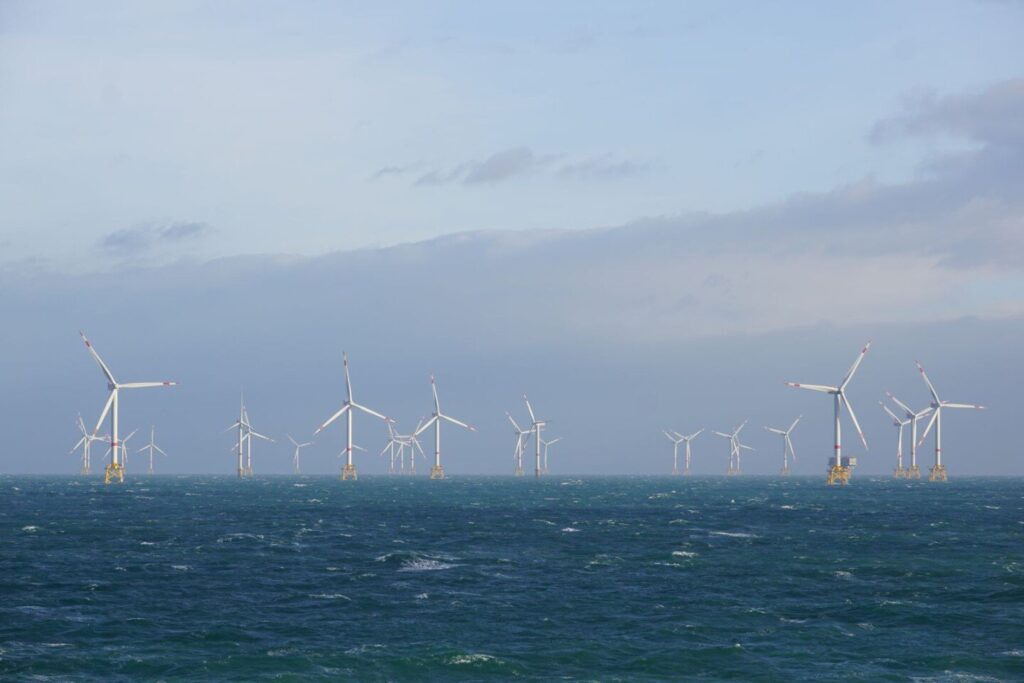Maintaining wind turbines and identifying potential vulnerabilities is expensive and time-consuming, especially when they are located offshore. As a result, rotor blades are often simply replaced, a costly process when damage is merely suspected. The Fraunhofer Institute for Integrated Circuits IIS, working in concert with the Fraunhofer Institute for Wind Energy Systems IWES, has developed a solution that can be used to identify cracks and breakage inside the blades remotely at an early stage.
Wind turbines are often located offshore, making them difficult to access for maintenance. A new chip has been developed to help detect damage remotely.
Cracks, breakage and erosion in rotor blades are common causes of failure in wind turbines. Offshore wind farms are at special risk, as they are exposed to exceptionally strong winds, rain and other severe weather conditions at sea. Because these facilities are hard to access, inspections are costly and time-consuming, which is why rotor blades are sometimes simply replaced when damage is merely suspected. The costs can run to well over 200,000 euros per blade per incident.
Structure-borne sound sensors detect damage
A division of Fraunhofer IIS is working with Fraunhofer IWES on a solution: “Our goal is to use acoustic emission sensors to reliably monitor damage to rotor blades remotely, thereby helping to ensure that wind turbines are available and do not fail,” says Björn Zeugmann, group manager at Fraunhofer IIS in the area of analog integrated circuit design, describing the project’s objectives.
To that end, he and his colleagues worked together to develop a special chip used in the sensors. The sensors, which are stuck to the individual rotor blades from inside, absorb sound waves traveling through the structure of the blades.
One challenge is that unlike with a steel beam, for example, the material is not homogeneous. Instead, rotor blades consist of different layers. The newly developed chip captures signals known as surface waves, which are created in the event of damage such as a crack. It then transmits these signals, for example, via mobile communications.
What makes this technique special is that unlike conventional measurement systems such as radar systems or drones that collect and transmit all the raw data, the Dresden-based researchers’ new chip transfers only anomalous information: “We use an acoustic system that detects damage based on the sounds it makes, so it can tell the difference between a crack that is forming inside the rotor blade and a break, for example,” Zeugmann explains.
Fraunhofer IWES developed this acoustic solution in a previous project. Extracting characteristic features makes it possible to significantly reduce the data volume so it can be transmitted via a mobile network in the first place. “Our chip is always listening, which means, ideally, it can classify and transmit information on potential damage from inside the rotor blade itself,” says Zeugmann.
Going forward, this should make it possible to determine, first, whether damage has in fact occurred at all and the turbine needs to be shut down in the worst case. Second, it will also help reduce the number of unnecessary service missions to hard-to-reach offshore wind farms and optimize service because damage can be monitored over a longer period. If the damage gets worse and emits noise, the sound is detected, so technicians can perform a targeted inspection and repair the issue as needed.
Compared to existing measurement methods, the new solution is smaller and more energy-efficient and uses significantly less data since it transmits smaller data packages. This means there is also no need for a broadband internet connection to transmit relevant information from the wind farms to the mainland.
In two prior projects, Fraunhofer IIS and Fraunhofer IWES have already worked together to develop an initial prototype of the chip that can be used to detect damage. The successor project, now in progress, was launched on June 1. In the project, the researchers are planning to expand the overall system so it can also detect lightning strikes—and the potential consequences—down the road. This has not been possible thus far, but especially for offshore wind farms, this additional information is crucial.
Zeugmann adds, “I’m fascinated by working in a field of the future like the energy transition and creating value for society that way.”
Citation:
Remote detection system developed for wind turbine blade damage (2025, August 1)
retrieved 4 August 2025
from https://techxplore.com/news/2025-08-remote-turbine-blade.html
This document is subject to copyright. Apart from any fair dealing for the purpose of private study or research, no
part may be reproduced without the written permission. The content is provided for information purposes only.

